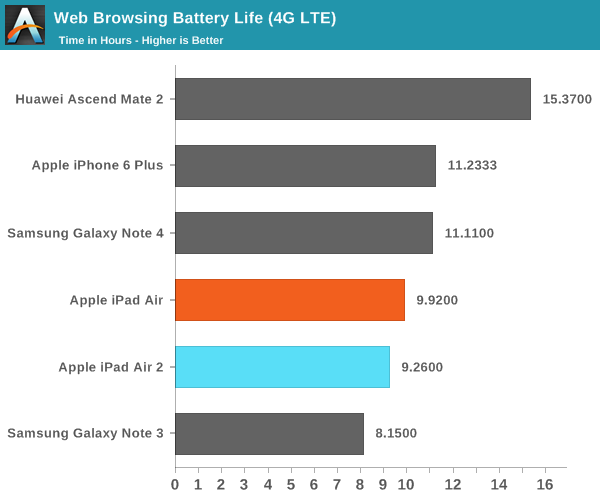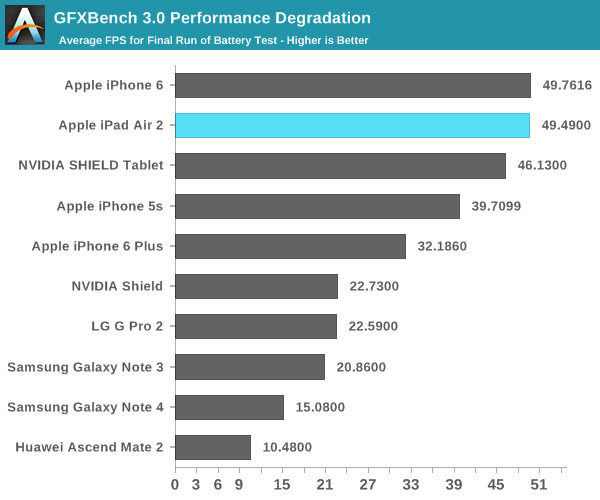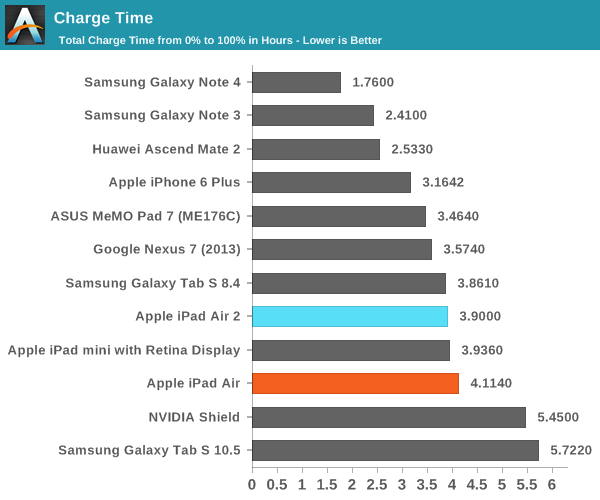The Apple iPad Air 2 Review
by Joshua Ho on November 7, 2014 9:30 AM EST- Posted in
- Tablets
- Apple
- Mobile
- iOS
- ipad Air 2
Battery Life
With the move from featurephones to smartphones, battery life has been and continues to be a critical issue. While it wasn’t unusual to see a week or more of battery life on a featurephone, some of the earliest smartphones couldn’t even last a day. While tablets seem to have a much easier time achieving high levels of battery life by virtue of massively increased volume, they still face similar issues as they are often used for gaming or other more intensive workloads that a smartphone is unlikely to see nearly as often. In order to test this, we run our tablets through a standard suite of tests of various use cases. In all cases where the display is on, all displays are calibrated to a brightness of 200 nits to draw useful relative comparisons.

In our first test, we see that the iPad Air 2 is about roughly equivalent to the original iPad Air for WiFi web browsing. This is actually a bit surprising as the battery in the iPad Air 2 is approximately 84% of the iPad Air. This would mean that we would expect the iPad Air 2 to get around 8.4 hours of battery life in this test, which represents a 16% gain to efficiency. It’s likely that these improvements to battery life come from the new process node on the A8X, along with the newer WiFi module.

Along the same lines, the LTE web browsing test tracks quite closely but it seems that there’s a minor decrease in efficiency gains when compared to WiFi. This difference is likely to be explained by the much higher bandwidth available in WiFi when compared to LTE.
While the web browsing tests are effective at ensuring faster SoCs aren’t punished, this inherently tilts battery life towards a more display-bound mode rather than compute-bound. Unfortunately short of a jailbreak it doesn’t seem possible to get an effective Basemark OS II battery test, so we’re mostly limited to a test of GFXBench’s unlimited rundown.


As one can see, the iPad Air 2 is one of the best performers on this test, considering its frame rate and runtime. While NVIDIA's GK20A GPU in Tegra K1 can get close to the GX6650 for short periods of time, over a long workload it's pretty clear that the GX6650 on 20nm has better sustained performance and significantly superior efficiency as it doesn't throttle until the 200th iteration of the test. It's important to note that the iPad Air 2 is running at a higher native resolution here, so relative to SHIELD Tablet a scaling factor needs to be estimated in order to get an idea for performance at the same resolution. During this test I saw that the skin temperatures never exceeded 45C, so this isn't the result of Apple choosing to run the device hotter than most.
Charge Time
While tablets deliver some great battery life in general, charge time tends to be much slower than that of smartphones as the battery is much larger and charging the device isn't as time critical due to the longer battery life . While we can't quite cover the full range of battery life uses cases, it's important to remember that in cases where the platform is otherwise identical beyond display that battery life scales linearly with overall capacity. In order to test charge time, we measure the time it takes for the battery to reach 100% from a fully-depleted state.

As one can see, the smaller battery seems to have a noticeable impact on charge time, although the difference isn't really all that notable as the difference is only around ten minutes at the end of the day.











226 Comments
View All Comments
Sushisamurai - Friday, November 7, 2014 - link
You should mention in the design segment, that there is a consequence with the thinness. I was playing some media (TV show, the 100, gotham), and due to the thinness, with the volume turned up, the iPad would reverberate/vibrate due to the audio output.In my opinion, the loss of a few millimetres was not worth this trade off, as my iPad 2 never shook when playing music or movies from its speakers at full blast.
chaosbloodterfly - Friday, November 7, 2014 - link
My old HP touchpad used to do that, but the sound quality was really good (and loud) for a tablet (like comparable to your average bluetooth speaker box things).Sushisamurai - Friday, November 7, 2014 - link
I noticed you added it in the misc section. It is still a design consideration IMO. Tomato tomato. It's my only gripe with the iPad Air 2. That and maybe ios8 - it's still a little buggy for me.KPOM - Friday, November 7, 2014 - link
Another thorough review by AT. I think software should be the next major focus for Apple with the iPad. The CPU and GPU power are getting to the point where the iPad could replace a laptop, provided the software were there. Maybe we'll see true multitasking and split window displays if and when the iPad Pro comes out with a 12+" screen. That third CPU core must be there for more than just games.steven75 - Friday, November 7, 2014 - link
I think they are heading this way.-iPad Pro rumors
-IBM deal
-MS Office (iWork since 2011, but still)
-iCloud Drive and support for third party cloud storage in the native file picker.
And now beefed up hardware that makes more sense for laptop-type usage.
esterhasz - Friday, November 7, 2014 - link
Good points and you're probably right.But I still think that multitasking is great on a desktop/laptop not so much because of the windows, but because of the control scheme: using the dominant hand for the pointer (like on touch) and the other for focus switching (like between programs) is just so insanely efficient. Bringing in the second hand for doing something simply does not work that fluidly on a touch device. And that would ultimately hamper the direction you're describing.
Or I may simply suck at touching.
ABR - Friday, November 7, 2014 - link
It's amusing to me when people talk about needing to multitask on tablets. 90% of the people I see using 24" desktops zoom every window they use to full-screen. It's actually HARDER to read the long lines of text or mouse around large expanses of blank space this way, but people like to focus on one thing at a time I guess. I tend to be more of the "use virtual space to organize the workflow" type when I've got that kind of real estate, but I rarely have the desire to do more than switch between fullscreen apps on a tablet.Still, we may see Apple add some kind of split-screen mode if only because people think they want it, like they gave us the comically unwieldy iPhone 6+.
Crackhour - Saturday, November 8, 2014 - link
I have the samsung 10.1 2014 edition and I never split screen. I like to focus on one screen so it seems. Apple seem to know this is reason it hasn't adopted the split screen my opinion. It just negates you the choiceStealthX32 - Friday, November 7, 2014 - link
Uhm, what planet do you live on where Apple cares about anything but the consumer market? Hmm, instead of giving developers incentives to write on OSX/iOS, let's give U2 $100 million dollars instead. Yeah, that's what will advance them as a company.ams23 - Friday, November 7, 2014 - link
Josh, don't you think it is a bit misleading to show a chart with a long-term fps of 46fps for Shield tablet in the GFXBench T-Rex Onscreen test when it was able to maintain an fps of ~ 55fps for the first 100 (!) continuously looped runs of the test (which represents nearly two hours of continuous use!)? I don't see how the 46fps is a realistic number for comparison. Even the GFXBench website lists a long-term median performance result of ~ 55fps for Shield tablet.Also note that Tegra K1 has higher render quality in GFXBench than A8X and any other ultra mobile SoC, so it is doing more work in that test.
A8X is a fantastic SoC and iPad Air 2 is an awesome tablet, but do note that iPad Air 2 has some significant performance-reducing throttling in both Geekbench 3 and 3dmark Ice Storm Unlimited. With long-term testing, the performance of A8X drops by ~ 30% in Geekbench 3 and drops by ~ 15% in 3dmark Ice Storm Unlimited: http://www.notebookcheck.net/Apple-iPad-Air-2-A156...
(It is my understanding that Shield tablet has virtually no CPU/GPU throttling due to use of the internal magnesium plate to dissipate heat).
On a side note, here is what OlegSH had to say about the GFXBench 3.0 T-Rex Onscreen test: "It's strange to see GLBenchmark 2.7 test as battery life test in GFXBench 3.0
Kishonti uses low precision FP16 shaders for T-Rex by default, that has quite noticeable impact on picture quality, just look at MP(medium precision) PSNR, hence the perfect MP PSNR for K1, looks like K1 doesn't support FP16. This combined with small amount of geometry, very simple shaders, lots of blending make this test perfect fit for tiled architectures. I don't believe lifetime results will stay the same once they move to Manhattan as power test".